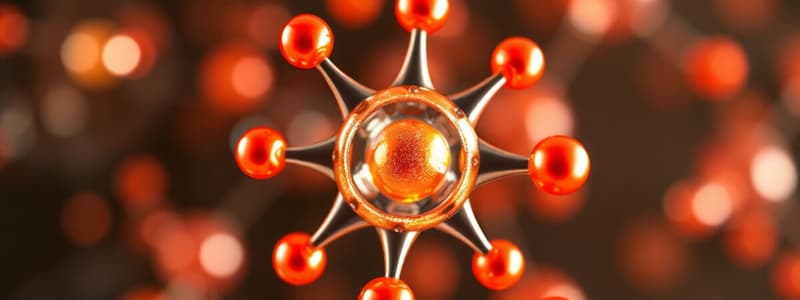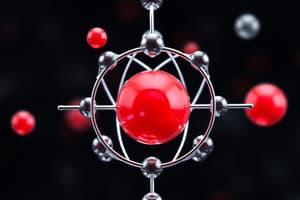Podcast
Questions and Answers
What is the peak with the largest m/z value in mass spectrometry called?
What is the peak with the largest m/z value in mass spectrometry called?
- Base peak
- Isotope peak
- Fragment ion
- Parent ion (correct)
Mass spectrometers can be used for radioactive dating.
Mass spectrometers can be used for radioactive dating.
True (A)
What is the first ionisation energy?
What is the first ionisation energy?
The energy required when one mole of gaseous atoms forms one mole of gaseous ions with a single positive charge.
The equation for first ionisation energy can be represented as H(g) → H+ (g) + ______
The equation for first ionisation energy can be represented as H(g) → H+ (g) + ______
Match the following applications of mass spectrometers with their uses:
Match the following applications of mass spectrometers with their uses:
Which of the following is not a use of mass spectrometers?
Which of the following is not a use of mass spectrometers?
The molecular ion peak is always the most abundant peak in a mass spectrum.
The molecular ion peak is always the most abundant peak in a mass spectrum.
What does the m/z value represent in mass spectrometry?
What does the m/z value represent in mass spectrometry?
What type of bonding is primarily found in silicon (Si)?
What type of bonding is primarily found in silicon (Si)?
S8 has a higher melting point than P4 due to stronger London forces.
S8 has a higher melting point than P4 due to stronger London forces.
What is the primary reason for the low melting and boiling points of Cl2?
What is the primary reason for the low melting and boiling points of Cl2?
The melting point of S8 is influenced by the number of _____ it has compared to P4.
The melting point of S8 is influenced by the number of _____ it has compared to P4.
Match the following substances with their correct properties:
Match the following substances with their correct properties:
What is the definition of second ionisation energy?
What is the definition of second ionisation energy?
The first ionisation energy is always larger than the second ionisation energy for an element.
The first ionisation energy is always larger than the second ionisation energy for an element.
What happens to the attraction experienced by the remaining electrons after the removal of the first electron?
What happens to the attraction experienced by the remaining electrons after the removal of the first electron?
The larger the atom, the further the outer electrons are from the nucleus, resulting in _______ attraction.
The larger the atom, the further the outer electrons are from the nucleus, resulting in _______ attraction.
Match the factors affecting ionisation energy with their descriptions:
Match the factors affecting ionisation energy with their descriptions:
What represents the process of second ionisation energy in a chemical equation?
What represents the process of second ionisation energy in a chemical equation?
Shielding refers to the effect of outer electrons on the inner electrons of an atom.
Shielding refers to the effect of outer electrons on the inner electrons of an atom.
Explain why successive ionisation energies become larger.
Explain why successive ionisation energies become larger.
What does a large jump in ionisation energy indicate about an element's group placement?
What does a large jump in ionisation energy indicate about an element's group placement?
The ionisation energy of an element increases as more electrons are removed from the outer shell.
The ionisation energy of an element increases as more electrons are removed from the outer shell.
What group of the periodic table does the element belong to if there is a significant increase between the 2nd and 3rd ionisation energies?
What group of the periodic table does the element belong to if there is a significant increase between the 2nd and 3rd ionisation energies?
The first ionisation energy of helium is _____ compared to other elements.
The first ionisation energy of helium is _____ compared to other elements.
Match the following terms with their descriptions:
Match the following terms with their descriptions:
Which factor contributes to the increased ionisation energy when removing the third electron?
Which factor contributes to the increased ionisation energy when removing the third electron?
The shape of the graph for ionisation energies across periods two and three is different.
The shape of the graph for ionisation energies across periods two and three is different.
Why does helium have the largest first ionisation energy?
Why does helium have the largest first ionisation energy?
What does the relative atomic mass represent?
What does the relative atomic mass represent?
The m/z value for a 24Mg2+ ion is 12.
The m/z value for a 24Mg2+ ion is 12.
What formula is used to calculate the relative atomic mass (R.A.M)?
What formula is used to calculate the relative atomic mass (R.A.M)?
The isotopes of chlorine are Cl35 and Cl37, with percentages of __________ and __________, respectively.
The isotopes of chlorine are Cl35 and Cl37, with percentages of __________ and __________, respectively.
Match the isotopes with their respective abundances.
Match the isotopes with their respective abundances.
Which of the following is true regarding mass spectra?
Which of the following is true regarding mass spectra?
Relative atomic mass calculations require the total number of isotopes.
Relative atomic mass calculations require the total number of isotopes.
How are the m/z values in a mass spectrum calculated?
How are the m/z values in a mass spectrum calculated?
For the molecule C4H10, the mass spectrometer produces a spectrum that often includes __________ peaks due to fragmentation.
For the molecule C4H10, the mass spectrometer produces a spectrum that often includes __________ peaks due to fragmentation.
Match the isotopes with their elements.
Match the isotopes with their elements.
What happens when the second electron is added to a 3p orbital?
What happens when the second electron is added to a 3p orbital?
The second ionisation energy pattern is the same as the first, but shifted one to the right.
The second ionisation energy pattern is the same as the first, but shifted one to the right.
Which electron configuration represents phosphorus?
Which electron configuration represents phosphorus?
Lithium's second ionisation energy is _____ than that of helium.
Lithium's second ionisation energy is _____ than that of helium.
Match the element to its respective second ionisation energy trend:
Match the element to its respective second ionisation energy trend:
Which of the following elements has the second largest ionisation energy?
Which of the following elements has the second largest ionisation energy?
Sulfur has an electron configuration ending in 3p4.
Sulfur has an electron configuration ending in 3p4.
In which shell is the second electron of lithium primarily found?
In which shell is the second electron of lithium primarily found?
Flashcards
Relative Atomic Mass (RAM)
Relative Atomic Mass (RAM)
The average mass of an element's atoms, taking into account the relative abundance of its isotopes.
Isotopes
Isotopes
Different forms of an element that have the same number of protons but different numbers of neutrons.
Isotopic Abundance
Isotopic Abundance
The percentage of each isotope present in a naturally occurring sample of an element.
RAM Calculation Equation
RAM Calculation Equation
Signup and view all the flashcards
Mass Spectrometry
Mass Spectrometry
Signup and view all the flashcards
Mass Spectral Peak
Mass Spectral Peak
Signup and view all the flashcards
Mass-to-Charge Ratio (m/z)
Mass-to-Charge Ratio (m/z)
Signup and view all the flashcards
Fragmentation
Fragmentation
Signup and view all the flashcards
Mr
Mr
Signup and view all the flashcards
Mass Spectrum for a Molecule
Mass Spectrum for a Molecule
Signup and view all the flashcards
Molecular Ion Peak
Molecular Ion Peak
Signup and view all the flashcards
Ionization
Ionization
Signup and view all the flashcards
First Ionization Energy
First Ionization Energy
Signup and view all the flashcards
Isotopic Composition
Isotopic Composition
Signup and view all the flashcards
Radioactive Dating
Radioactive Dating
Signup and view all the flashcards
Molecular Identification
Molecular Identification
Signup and view all the flashcards
Pharmaceutical Applications
Pharmaceutical Applications
Signup and view all the flashcards
Second Ionisation Energy
Second Ionisation Energy
Signup and view all the flashcards
Third Ionisation Energy
Third Ionisation Energy
Signup and view all the flashcards
Nuclear Attraction
Nuclear Attraction
Signup and view all the flashcards
Distance from Nucleus
Distance from Nucleus
Signup and view all the flashcards
Shielding Effect
Shielding Effect
Signup and view all the flashcards
Trend in Ionisation Energies
Trend in Ionisation Energies
Signup and view all the flashcards
Ionisation Energy Jumps
Ionisation Energy Jumps
Signup and view all the flashcards
Ionisation Energy Trend (Across Period)
Ionisation Energy Trend (Across Period)
Signup and view all the flashcards
Ionisation Energy Trend (Down Group)
Ionisation Energy Trend (Down Group)
Signup and view all the flashcards
Core Electron Shielding
Core Electron Shielding
Signup and view all the flashcards
Periodicity
Periodicity
Signup and view all the flashcards
Melting and boiling points are affected by bond strength
Melting and boiling points are affected by bond strength
Signup and view all the flashcards
What are macromolecules?
What are macromolecules?
Signup and view all the flashcards
What are simple molecular substances?
What are simple molecular substances?
Signup and view all the flashcards
How does molecular size affect London forces?
How does molecular size affect London forces?
Signup and view all the flashcards
What are monoatomic substances?
What are monoatomic substances?
Signup and view all the flashcards
Why does sulfur have a lower second ionisation energy than phosphorus?
Why does sulfur have a lower second ionisation energy than phosphorus?
Signup and view all the flashcards
Why do group 1 elements appear at the peaks of the 2nd Ionisation Energy graph?
Why do group 1 elements appear at the peaks of the 2nd Ionisation Energy graph?
Signup and view all the flashcards
Why does lithium have a higher second ionisation energy than helium?
Why does lithium have a higher second ionisation energy than helium?
Signup and view all the flashcards
Ionisation Energy
Ionisation Energy
Signup and view all the flashcards
How does the distance between the nucleus and the electron affect ionization energy?
How does the distance between the nucleus and the electron affect ionization energy?
Signup and view all the flashcards
Study Notes
Atomic Structure and the Periodic Table
- Atoms are composed of protons, neutrons, and electrons.
- Protons have a positive charge, neutrons have no charge, and electrons have a negative charge.
- Protons and neutrons are located in the nucleus, while electrons orbit the nucleus.
- Atomic number (Z) represents the number of protons in an atom.
- Mass number (A) is the total number of protons and neutrons.
- Isotopes are atoms of the same element with different numbers of neutrons.
- Relative isotopic mass compares the mass of an isotope to one-twelfth the mass of a carbon-12 atom.
- Relative atomic mass is the weighted average mass of an atom compared to one-twelfth the mass of a carbon-12 atom.
- Relative molecular mass is the average mass of a molecule compared to one-twelfth the mass of a carbon-12 atom.
Mass Spectrometer
- Mass spectrometers determine the isotopes present in a sample.
- They identify elements by measuring the mass-to-charge ratio (m/z) of ions.
- Relative atomic mass is calculated as a weighted average of isotopic masses.
- The spectrometer's output shows a spectrum with peaks corresponding to different isotopes.
- Each peak represents an isotope, its abundance and its m/z value.
Ionization Energies
- The first ionization energy is the minimum energy needed to remove one electron from each atom in a mole of gaseous atoms.
- Successive ionization energies are progressively higher because removing electrons from a positively charged ion requires more energy.
- Ionization energy trends: It tends to increase across a period due to increasing nuclear charge. It tends to decrease down a group due to increased electron shielding and larger atomic radius. There are occasional irregularities.
- Factors affecting ionization energy: Effective nuclear charge, atomic radius and shielding.
- The large jump between successive ionization energies indicates the removal of an electron from a different energy level. This can be used for identifying the electronic structure of an element.
Studying That Suits You
Use AI to generate personalized quizzes and flashcards to suit your learning preferences.




